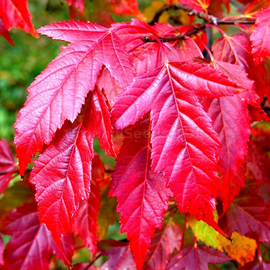




Organic Amur Maple Seeds (Acer Ginnala)
1.14 €
The Amur Maple is native to Northeast China and Japan. Amur maple has only started to attain popularity as a bonsai. It can be grown as a multi-stemmed clump or can be trained into a small tree with a single trunk. The tree grows about 20 to 30 feet tall.
-
Organic Amur Maple (Acer Ginnala)
The Amur Maple is native to Northeast China and Japan. Amur maple has only started to attain popularity as a bonsai. It can be grown as a multi-stemmed clump or can be trained into a small tree with a single trunk.
The tree grows about 20 to 30 feet tall in the wild. The bark is smooth, reddish in color and fairly thin. Acer Ginnala takes well to bonsai techniques. Due to excessive branchiness, some pruning is required early in the life of the tree to create dominant major branches. It tolerates heavy pruning. New shoots should be pruned through the growing season.
Acer Ginnala may be wired, but like other maples, may require some protection of the bark. It is the only one of the simple-leaved maples for which the leaves are clearly longer than wide and the terminal lobe is much longer than the lateral lobes, often twice as long or more. Its Summer color is green, but is mixed with bright red samaras or 'helicopters' in Midsummer.
This hardy tree and its varieties typically produce very colorful yellow to orange Fall foliage. Its leaves will reduce to under one inch if it is defoliated once every two years in mid-Summer. It develops clusters of fragrant, yellowish-white flowers in Spring. It is one of the very few maples that have fragrant flowers. Hardiness zones 3-8, (-10°C/15°F,-37°C/-35°F) in Winter.
Very weather resistant, in fact, it is more tolerant of adverse conditions than most other maples. May be grown in somewhat hotter areas if care is taken to prevent leaf-burn or dehydration. These deciduous trees are best grown in normal garden soil. Best in moist, well drained soils, but also tolerates dryness; tolerates neutral soil pH; salt tolerant.
It is a vigorous grower that is very tolerant of temperature extremes. Full sun or partial shade; but part shade in Midsummer and in very hot climates to prevent leaf burn. Amur Maple likes moderate watering. Increase watering during the Summer heat, and keep fairly dry in Winter. It is drought resistant once established.
Planting features:
Ginnala maple is lubricated in open areas or in partial shade. Plants with decorative leaf coloring lose their color when planted in the shade.
The root collar is at ground level. In plants that produce abundant root shoots, it is slightly deepened - up to 5 cm.
If groundwater is close, drainage is required, consisting of crushed stone in a layer of 10-20 cm.
Soil mixture: Humus or peat compost, turf soil, sand - 3: 2: 1.
For field and silver maple - leaf soil, peat, sand - 2: 2: 1.
It is possible to add a complete mineral fertilizer (120-150 g of nitroammophoska) to the planting hole
Optimum acidity is pH 6.0 - 7.5, for red maple - pH 6.0 - 7.5
Feeding: If fertilizers were not added during planting, then in the spring of the year following planting, add:- urea (40 g / sq.m),
- potassium salts (15-25 g / sq.m),
- superphosphate (30-50 g / sq.m).
In summer, when loosening and watering, add kemira (100-120 g / sq.m).
Watering: After planting - 20 liters per plant. Most maples can tolerate dry soil, but grow better with watering.
The watering rate during the dry season is 10-20 liters per plant once a week.
With normal rainfall of 10-20 liters per plant once a month.
Loosening: Shallow, regular, during weeding and after watering, to avoid soil compaction.
Mulching: After planting, the soil near the plants is mulched with peat or earth with a layer of 3-5 cm.
Pruning: Dry and diseased branches must be pruned.
Pests:- Whitefly
- Mealybug
- Leaf weevil
- Powdery mildew
- Black spot
If damaged by frost, annual shoots must be cut off. The crown will be restored due to new shoots that have time to lignify before the onset of frost.
Standard plants should be covered for protection from frost cracks in the first 2-3 years after planting, wrapping the trunk with 1-2 layers of burlap. Their winter hardiness increases with age.
